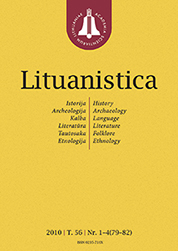LituanisticaWHAT?
 ISSN 0235-716X |
2004 m. Nr. 1 Lietuvių tradicinių piršlybų struktūros pokyčiai XX a. II pusėje
Ethnologists seeking to reveal a range of social, cultural or other changes of human life usually look for the areas in which these changes are most prominent. In this respect, wedding represents a most important rite in the human life cycle. Its modifications reflect social and cultural dynamics, and vice versa. Weddings as an object of research are used to study communications and national or cultural identities. Other cultural identities are formed naturally in different age groups (generations) and they became especially distinct in wedding customs of the second half of the 20th century On the basis of manuscript and ethnographic field research materials as well as ethnological and ethnographic literature, an attempt is made to show that changes in wedding rites reveal modified cultural identities. The goals of the current work were to perform a structural and functional analysis of a wedding agreement concluded between a young couple and their parents and to show how the significance of traditional wedding customs was understood in the family.
The structure and also the nature of the courtship procedure changed in the second half of the 20th century. The change was caused by the weakening of a basic factor, namely the young couple’s dependence on parents’ decision to give or not to give their consent to the proposed marriage. The functions of newly-remodelled courtship (formerly “match-making”) covered the notification of parents about the marriage by the young couple and the agreement relating to wedding arrangements. To be more precise, I suggest calling it an ‘agreement-making procedure’, that is, a part of the wedding cyple when the young couple inform their parents about their decision to marry, when the families get acquainted and discuss wedding arrangements. In the second half of the 20th century, the third party did not withdraw from agreement-making altogether yet their role and functions were usually unimportant. In the seventies of the 20th century the match-maker did not participate in agreement-making. A new circumstance in agreement-making evolved, such as notification by the young couple of their parents about the intention to marry after the filling of applications for civil registration. However, they do not change the essential character of agreement-making. In agreement-making, the parents discuss issues related to the wedding while the children usually submit to the parents’ judgement in this matter. Compared to agreement-making customs practised by Russian “highbrows” living in towns (known from the early 20th century), weddings of Lithuanian village or small-town dwellers managed to retain longer a number of traditional points in the area of family relations: (1) the dominance of parents’ will in terms of the wedding character; (2) the stereotyped characteristics of the thinking of females (revealed as a result of their wish to maintain customs). A combination of structural and comparative methods used in the research provides evidence to a connection between the changes and evolution in courtship practised by Lithuanians and residents of neighbouring countries and the general processes of modernisation. In the opinion of Lithuanian village dwellers, a solemn wedding means immortalisation of this important moment of life, a memorable event, and an opportunity to promote family tradition. |
Numeriai:
2011 - T.57 Nr.1, Nr.2, Nr.3, Nr.4 2010 - T.56 Nr.1-4 2009 - T.55 Nr.1-2, Nr.3-4 2008 - T.54 Nr.1, Nr.2, Nr.3, Nr.4 2007 - T.53 Nr.1, Nr.2, Nr.3, Nr.4 2006 Nr.1, Nr.2, Nr.3, Nr.4 2005 Nr.1, Nr.2, Nr.3, Nr.4 2004 Nr.1, Nr.2, Nr.3, Nr.4 2003 Nr.1, Nr.2, Nr.3, Nr.4 2002 Nr.1, Nr.2, Nr.3, Nr.4 2001 Nr.1, Nr.2, Nr.3, Nr.4 |